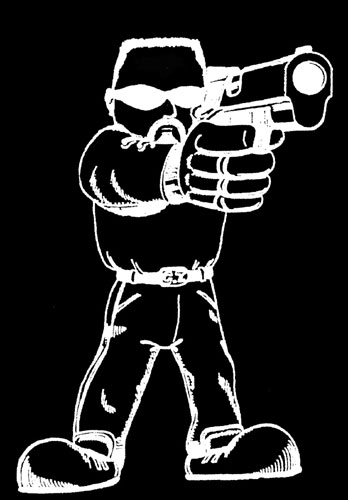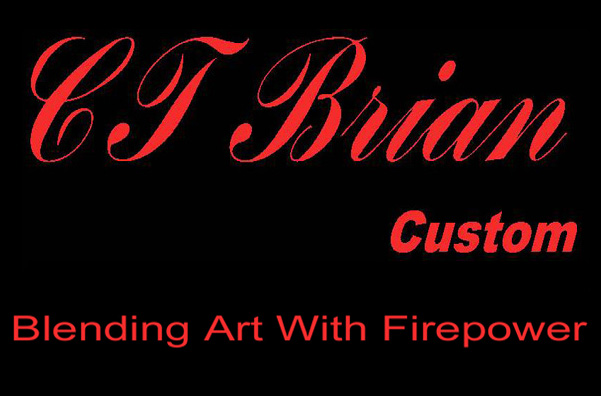

| Home | Greeting | Catalog | Magazine Articles | Photos | Links | Contact | Ordering |
|
*The
CHOPPER |
* SideWinder |
Due to my current backlog, I am only accepting orders for full house customs.
CT BRIAN'S BIG-LITTLE SOLUTION
By Larry Pomykalski, Photos by Ichero Nagata
Excerpts from AMERICAN HANDGUNNER Mar/Apr 2006
It's a
dangerous thing to speculate about your dream gun around
a custom
pistolsmith. While we mear mortals are in no
danger of
turning
all those crazy specifications into actual, functioning
firearms, give
that same idea to a master of the pistolsmithing art and
things can
change, often rapidly. A law-enforcement type
recently
learned
this when he started the "what if?" game around CT
Brian, a Master
Pistolsmith with a history of turning ideas into
polished tool steel.
The conversation started with, "You know, I can't
believe
nobody
has ever built the ultimate pistol." The gauntlet
was tossed.
Seems this cop, a
Colorado area peacekeeper named Tom Early, got to
thinking about how all those other mulitgun sets, with
multiple slides
fitted to a single frame so as to go from duty ready
full-size gun to
mini-size concealmeant gun, were going about it just
about backwards.
He reasoned, quite logically, a commander length slide
worked pretty
darn well for both on- and off-duty
carry, but the frame was the part
needing a size adjustment.While plenty of
people do - and many are doubtless doing it right now -
concealing a full-size 1911 frame requires a bit of
work, a good
holster, the right attitude and the right attire.
If you're
on
the thinner side, it requires even more work, since
there's simply less
waist band to work with. And while many get around
this by
switching guns, the obivously bright Mr. Early realized
an officer's
sized-frame mated to the same commander length slide,
was probably just
the ticket for a concealment gun. Hmmm.....
But
most
people
agree that mini-frame isn't ideal for duty carry.
In an open holster, the standard commander sized
frame
carried
just fine, and gains a round in capacity.
Handles a bit
better,
too, for most types of shooting. So our
cop-friend decided he
wanted a commander frame fitted to this same slide.
Using the
same slide group meant accuracy and function would be
consistent
between the two variants, and careful fitting and
trigger work would
ensure the only noticeable difference in handling
would be the grip
size. Of course it would be nice if both
combinations shot
with
match accuracy, complete reliability, had a perfect
trigger pull and
looked sexy, too. Might as well want it all,
right?
Everybody who's a
serious shooter, and lots of people who aren't, sit
and speculate about building the perfect gun for a
particular purpose.
Not everybody does it around a pistolsmithing artist
like CT Brian, and
the proof is in the photos. Turns out that a
game of
"wouldn't it
be nice?" gets turned into hand-lapped parts and
immaculately-checkered steel pretty fast in the
Brian shop.
Meet
frame
number
one, the mini-frame.
Looks great, of
course,
since Tim Brian couldn't make an ugly gun if he tried.
First
thing you'll need to know, though, is beneath that
pretty exterior
lurks a genuine thug, since the Armour Tuff finish is
hiding a titanium
heart, as it turns out. But in spite of the renowned
difficulty of
machining titanium, all the usual touches from a Brian
custom are here:
immaculate 25 lpi checkering, contoured mainspring
housing
checkered to match and a commander hammer hooked up to
some precision
work under the hood to yield a "perfect-for-carry"
four-pound trigger
pull.
Little
touches like
a melted mag releasee and rounded butt help the
little guy hide effortlessly under casual attire and carry
with the
ease of a much smaller gun. Between the light weight
of the
Ti frame and the detail work Tim's done here, it's hard to
imagine a
.45 auto that could carry and conceal this easily.
Frame
number
two is
the commander-size frame. All steel here,
a bit of weight can help a duty pistol with recoil
control.
Same trigger and trigger pull, so there won't be
any
adjustment needed when Tom swaps frames.
Checkering on the
front strap and mainspring housing, while still
immaculate, is a bit
coarser at 20 lines per inch, adding some traction
during stress.
The mag release is a bit more prominent, with
checkering at a
genuinely spooky 50 lpi, replacing the melted button on
the mini.
There's a SuperWell mag well seamlessly melted
into the frame
to help keep the beast fed, and melted slide stop and
safeties that
will still feel good after a long day qualifying.
The
final
member of
this triumvirate is the commander-length
slide.
There are any number of serious gun-toters who will
swear the
commander-length slide is just about the perfect
compromise - big
enough to shoot well, small enough to hide easily.
They'll
get no argument from me or Mr. Early.
Tim
Brian starts
with the usual ejector tuning, ejection port
modification and other work that's defined as state of the
art in
combat 1911's. The .45 ACP barrel has been lapped to
fit the
slide, while the slide has been meticulously fitted to
each frame.
And while it may be difficult getting match accuracy
in
fitting a slide to one frame, the problems are exponential
in getting a
slide to fit two. That Brian has overcome these
issues is
proven by the match-level accuracy this system displays
with both frames.
That'll
keep a pistolsmith up nights.
After
performing all
the work that makes a 1911 run correctly, Tim does
the things that separate a high-quality, functional gun
from a work of
art. The first thing you notice along these lines is
Brian's
"FlatBack" treatment
given to the rear of the slide and the Heinie
sight. Instead of simply serrating both, Brian has
actually
mated the sight and slide into a continuous flat plane.
Essentially, the rear sight picture continues all
the way
down the rear of the slide. As Tim puts it, "It's
something
new I've been doing. It makes for a very fast sight
picture."
Tim then sights the pistol and custom-installs
tritium vials
that shoots perfectly to the actual point of aim.
Simple,
uncluttered and elegant, while improving usability and
function; much
like the rest of the pistol.
I
have to admit the
next feature is a matter of taste. As an
old-timer who grew up on 1911's without front serrations,
I've never
quite adjusted to their look (or use) on my guns.
And while I
know that many like to use them for press checks and
loading/unloading,
I've simply never found a need or desire for them on my
1911's.
It
appears Mr. Early
agrees, because he's had Tim Brian perform that
most beautiful of all cosmetic operations, the "High
Power" cut, on the
front of the slide. Removing a small amount of metal
from
just forward of the ejection port, this treatment gives
the slide a
classy, sophisticated look and still gives a surface to
grasp for
press-checks and the like. It's the finishing touch
on a
beautiful slide.
I've
mentioned more
than once that every combination of these parts
yields "match grade" accuracy. Just so we're clear
I'm not
fudging this description, I'm looking at five targets,
each with five
shots at 25 yards with the officer-size frame. The
largest
group is exactly 1". And while everyone would
probably agree
that level of accuracy isn't actually required in a
defensive fiream,
there isn't a serious shooter out there who wouldn't want
it in his own
gun - as long as he didn't have to trade reliability for
it.
With
a gun out of CT
Brian's shop, you don't. As Tim puts it,
"In a serious social encounter, you damn well better have
absolute
faith in the weapon you're carrying." Complete
reliability is
built into every Brian custom, before any other work even
begins.
So
we've established
this set of guns was built to some of the highest
standards available on this little blue rock we call home.
The question remains, however; how does it all
actually work?
Actually, very well, as it turns out.
The
fire controls
are exactly the same on both frames, the trigger
pulls are matched perfectly and the sight picture
(with that beautiful
flat sight plane), remains exactly the same
however the parts are
combined. The training and practice logged on one
configuration
translates seamlessly to the other, and the hand
and eye get to know
the whole assemblage as a single gun. And
yet you have the
convenient carry of a mini gun and the fighting
ability of a
commander-sized gun with less than a minute's
work. The idea
is
clever, and leaves you wondering why it's taken so
long for someone to
put it together.
CT
Brian has made a
reputation as a creator of precise, elegant 1911's
that ride in the holsters of serious shooters all
over the world.
While other 'smiths add CNC machining and
outsource
procedures to
increase their production, Tim keeps doing things
the way they were
done in the golden age of building custom guns.
"My
fear is that
hand building custom 1911's is a dying and soon to
be
lost art," said Tim. "And I'd much rather be
lumped in with
the
very few that did it the Old-World way," he
explains. And
while
good guns can be made in a variety of ways, I for
one am glad to hear
Tim does it his way.